
November 7, 2025
1141 Administration of Canton Zug
1141 Administration of Canton Zug
Location:
Zug, Switzerland
Project Phases:
Competition 1998; Realization 1999
Client:
Building Department of the Canton of Zug, Office of Structural Engineering
Landscape Architecture:
Studio Vulkan (formerly Zulauf Seippel Schweingruber Landscape Architecture)
Architecture/Art:
Christoph Haerle
Photography:
Studio Vulkan
Details:
In Zug, the Cantonal Court, the Cantonal Administration, and the correctional facility are in close proximity to one another. Their institutional affiliation is made visible through a deliberately restrained yet precisely articulated landscape design. The outdoor spaces envelop the buildings with minimalist material language, creating spatial continuity among the architectural volumes.
A variety of surface treatments – gravel turf, lawn, and asphalt – structure the exterior space into distinct zones of use. As a visual connector and contrasting element, numerous spherical planting vessels made of blue plastic emerge from the ground. These elements loosen the overall composition, create a cohesive visual field, and serve as striking focal points within the otherwise subdued context.
The positioning of these planters follows a compelling logic of order and randomness. Along the internal access road, they are arranged in a regular sequence; elsewhere on the site, they appear irregularly scattered – within a predefined grid yet placed according to random selection. This experimental setup, oscillating intentionally between structure and arbitrariness, responds to the spatial duality of open fields and linear circulation.
The deliberately artificial character of the containers, together with the specific planting strategy, addresses the challenging growing conditions of the site. The area is largely underlain by underground car park, resulting in limited soil depth and minimal water retention capacity. To ensure viable plant growth, the planters were equipped with deeper substrate volumes and planted with robust, drought-tolerant species. From these blue anchor points, vegetation begins – almost subversively – to colonize and connect the site. The selected species -including winter jasmine, butterfly bush, dog rose, boxthorn, and wild grapevine – are vigorous, resilient, and low-maintenance, making additional irrigation unnecessary. On the gravel turf areas, a pollinator-friendly plant cover is gradually establishing itself, supported by reduced mowing and maintenance cycles and the use of specific flowering seed mixes.